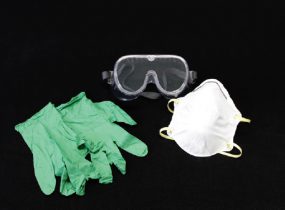Q Fever Fact Sheet
What is Q fever?
- Q fever is a disease in people and animals caused by the germ (bacteria) Coxiella burnetii.
- In animals, the disease is also known as coxiellosis (pronounced cox·e·el·low·sis).
What are the symptoms of Q fever in animals?
- Infected animals usually appear healthy.
- Infected, pregnant animals may experience abortions late in pregnancy.
Who is at risk?

Anyone who has contact with animals infected with Q fever bacteria, especially people who work on farms or with animals. Examples of high-risk jobs include:
- Livestock farmers
- Slaughterhouse workers
- Veterinarians
- Animal or laboratory researchers
How is it spread?
Q fever is most commonly spread to people by infected farm animals, including goats, cattle, and sheep.
People can get Q fever by:
- Touching feces, urine, milk, or blood from an infected animal.
- Breathing in dust that contains Q fever bacteria.
- Touching a newborn animal or birthing products (placenta, birth fluids) from an infected animal.
- Drinking raw (unpasteurized) milk.
What are the signs and symptoms of Q fever in people?
About half of people infected with Q fever bacteria will get sick with a flu-like illness. People may feel sick 2–3 weeks after contact with the bacteria.
Signs and symptoms can include:
- High fever
- Feeling tired
- Chills or sweats
- Headache
- Muscle aches
- Cough
- Nausea, vomiting, or diarrhea
- Chest pain
What is chronic Q fever?
A very small number of people with Q fever (less than 1 out of 20) develop a more severe illness called chronic Q fever. Chronic Q fever can result in infection of heart valves (called endocarditis). Symptoms may not appear until months or years after exposure.
Chronic Q fever is more likely to occur in people:
- With heart valve or blood vessel disease,
- With weakened immune systems,
- Who were pregnant when they first had Q fever.
Take steps to reduce your exposure.
- There is no vaccine to prevent infection in the United States.
- Avoid contact with infected animals during birthing when possible. If you assist in animal deliveries or have contact with birth products, protect yourself by wearing:

Gloves
- Eye protection (e.g., goggles)
- Protective clothing (e.g., coveralls and boots)
- Masks (an N95 or higher respirator is the most effective type of mask for protecting against Q fever bacteria)
- Talk to your healthcare provider about whether it is safe for you to wear a mask or respirator.
- Additional Occupational Safety and Health Administration requirements may apply. Talk to your employer.
- Shower and change your clothes and shoes after working with animals.
- Eat and drink only pasteurized milk and milk products (cheese, cream, butter).
What should I do if I am worried about Q fever?
- Contact your healthcare provider if you think you might have Q fever or if you are at risk for chronic Q fever. If you work or have worked with farm animals, make sure to tell your healthcare provider.
- Contact your veterinarian if you think your animals might have Q fever.